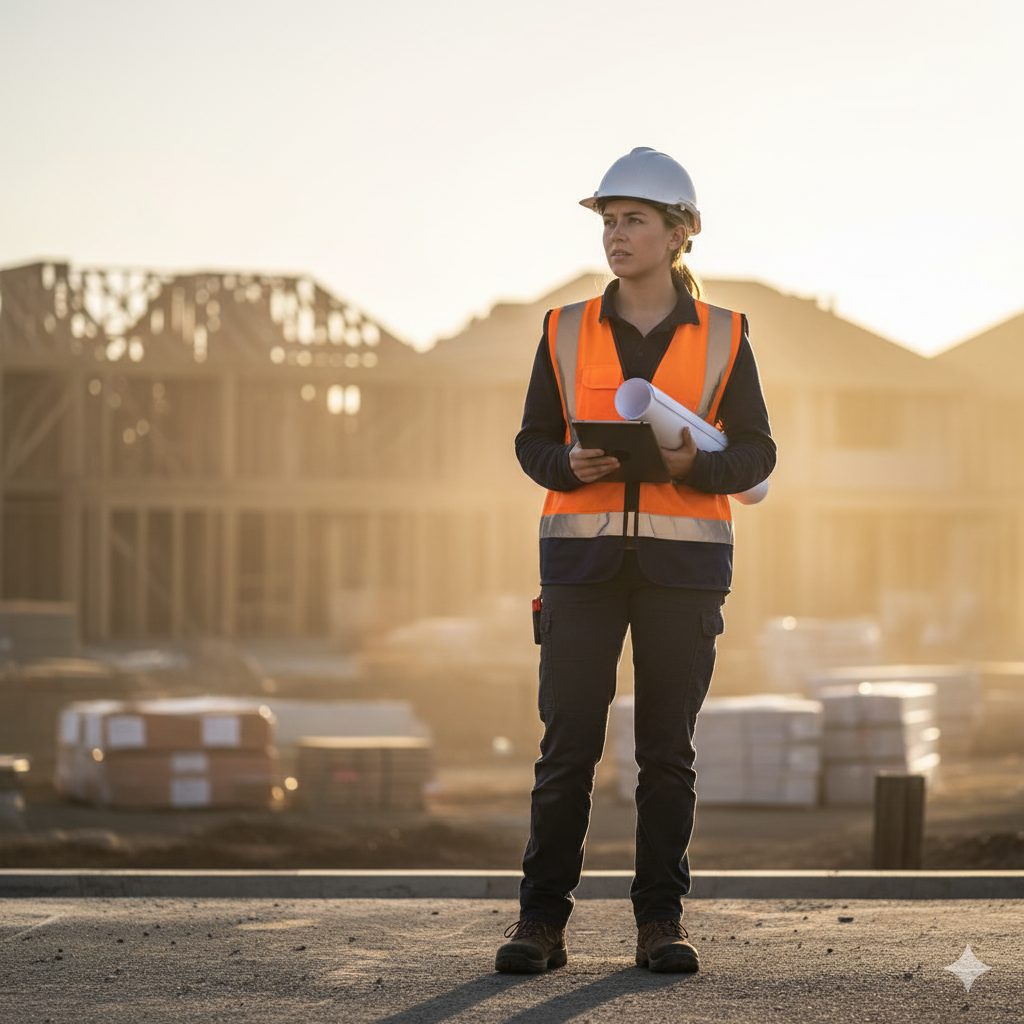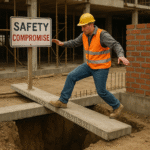|
Getting your Trinity Audio player ready...
|
Who is Going to Have My Back?
A Deep Dive into the Gap Between Recruitment Promises and Workplace Reality
By Angela Hucker, Founder, EPIC Services
I received an email last week that I can’t stop thinking about.
It came from a construction student—a young woman on the cusp of entering our industry, excited about her future, ready to contribute her skills and energy to building Australia’s homes and infrastructure.
She’d read a report about the challenges facing women in residential construction. Her email was raw, honest, and heartbreaking in its simplicity:
“It made me feel a bit anxious. I’ve been so excited to get started, but it makes you wonder… Is there a real plan to make sure women like me are actually safe and respected out there?”
“Who’s going to have my back when I’m new and don’t know what I’m doing?”
“Are we just expected to put up with how things have always been?”
These aren’t theoretical questions. They’re the reality check that every young woman faces before stepping onto a construction site for the first time. And after 25 years in this industry—from becoming Queensland’s first woman locksmith to working on mega infrastructure projects—I know she’s right to be concerned.
Because we’re asking women to join an industry that hasn’t done the work to keep them safe.

The Uncomfortable Truth About Construction’s Recruitment Crisis
Last week, BuildSkills Australia called for “targeted action” to recruit 51,000 additional women into residential construction over the next four years. The federal government needs 1.2 million new homes built by 2029, and the only way to meet that target is to dramatically increase female participation.
The math is simple: we need more workers, women represent an untapped talent pool; therefore, we should recruit more women.
But here’s what that equation misses:
We’re recruiting women into workplaces that are fundamentally unprepared to support them.
The University of Sydney Business School’s recent research—commissioned by the National Association of Women in Construction—laid bare the reality:
- Women are 30% more likely than men to leave construction due to workplace culture
- Pregnant women are “thrown to the wolves” with no guidance on role adjustments
- Assault, stalking, and harassment remain disturbingly common
- Women modify their reproductive decisions to fit inflexible job demands
- Only 4% of trade-qualified workers are women—up from just 2% a decade ago
That’s not a skills shortage. That’s a culture crisis masquerading as a recruitment problem.
When “Targeted Action” Ignores The Target
The BuildSkills report focuses heavily on recruitment: apprentice incentives, mid-career pathways, and marketing campaigns to attract women.
But recruitment without retention is just an expensive revolving door.
Bella Rogers’ story captures this perfectly. After becoming the first woman to graduate from her TAFE carpentry course in eight years—the only woman among 500 applicants—she faced assault by a trusted colleague, stalking, and repeated boundary violations.
When she became pregnant nine months into a salaried role, her employer initially refused to move her to light duties despite medical warnings that physical site work could cause miscarriage or serious injury. It took a doctor’s intervention to protect her health.
This is what we’re inviting young women into when we talk about “recruiting 51,000 additional women.”
The student who emailed me isn’t worried about whether she can learn carpentry or operate machinery. She’s worried about whether anyone will protect her when she’s harassed. Whether she’ll be thrown off-site if she gets pregnant. Whether experienced workers will mentor her or undermine her.
These fears aren’t paranoia. They’re pattern recognition.
The Questions No One is Asking
When industry bodies and government agencies develop recruitment targets, they focus on numbers: 51,000 women, 116,000 total workers, 1.2 million homes.
But the student who wrote to me asked different questions—the ones that actually matter:
“Is there a real plan to make sure women like me are actually safe and respected out there?”
Not a recruitment plan. A safety plan. A culture plan. A plan that addresses the systemic issues that have pushed women out of construction for decades.
The University of Sydney research identified specific barriers: inadequate female-only facilities, inflexible work hours incompatible with childcare, lack of appropriate PPE for pregnant workers, “presenteeism” culture that punishes taking sick leave, and persistent harassment and discrimination.
These aren’t mysteries. We know exactly what needs to change.
The question is: are we willing to change it?
“Who’s going to have my back when I’m new and don’t know what I’m doing?”
This question reveals something deeper than mentorship concerns. It’s about psychological safety—the fundamental confidence that when things go wrong, someone will support you rather than exploit your vulnerability.
In traditionally male-dominated workplaces, informal networks often exclude women. The “smoko shed culture” where relationships are built, information is shared, and mentorship happens naturally can be hostile territory for women who face inappropriate comments, sexual jokes, or deliberate exclusion.
When Bella Rogers was assaulted by a colleague she trusted, who had her back then? When she was stalked by another worker, who intervened? When she needed medical accommodation during pregnancy, who advocated for her safety?
The research shows this isn’t an isolated experience. Women across construction report being left to “work it out themselves”—a sink-or-swim approach that would be considered unacceptable negligence in any modern workplace.
“Are we just expected to put up with how things have always been?”
This is the question that should terrify every construction industry leader.
Because the answer young women are receiving—through their lived experiences, through stories like Bella’s, through the glacial 2% to 4% increase in female participation over a decade—is yes.
Yes, you’re expected to endure harassment.
Yes, you’re expected to risk your pregnancy.
Yes, you’re expected to work in facilities designed exclusively for men.
Yes, you’re expected to sacrifice family life for “presenteeism” culture.
Yes, you’re expected to accept less pay, fewer opportunities, and limited advancement.
And then we wonder why women leave.
The Cost of Getting This Wrong

Here’s what happens when we recruit women into unprepared workplaces:
For Individual Women:
- Career-ending trauma from harassment and assault
- Health risks during pregnancy due to inadequate support
- Financial insecurity from forced early departures
- Professional isolation and limited networks
- Delayed or foregone childbearing to accommodate inflexible work demands
For Employers:
- Turnover costs averaging $67,000 per skilled worker replacement
- Recruitment investment wasted when workers leave within months
- Reputation damage as word spreads through professional networks
- Legal liability from harassment and discrimination incidents
- Missed productivity from dysfunctional team dynamics
For the Industry:
- Continued skills shortage because retention remains abysmal
- Narrowed talent pool as women warn others away
- Government intervention and regulatory pressure
- Public perception damage affecting all recruitment efforts
- Lost innovation and perspectives from homogeneous workforce
For Australia:
- Failed housing targets and infrastructure delays
- Economic losses from construction sector inefficiency
- Continued gender pay gap and economic inequality
- Social costs of unsafe workplaces and mental health impacts
- Wasted education investment in women who leave the field
READ ALSO: How Toxic Culture Can Kill Construction Productivity [2025]
What Real Change Looks Like
Nearly 30 years in construction and working with over 200 companies on culture transformation, I can tell you exactly what needs to happen to make construction safe and welcoming for women.
It’s not rocket science. It’s commitment.
1. Zero Tolerance With Real Consequences
“Zero tolerance” policies are worthless without enforcement. Real change requires:
- Immediate response protocols when harassment is reported, not “we’ll look into it”
- Transparent investigation processes that protect reporters from retaliation
- Actual consequences for perpetrators, including termination for serious violations
- Support systems for victims, including counselling and career protection
- Regular audits to ensure policies are being followed, not just filed away
Case Example: One of our client companies implemented a policy where any harassment report triggers automatic removal of the accused from the project during investigation, with full pay maintained for both parties. Complaints dropped 80% within six months—not because harassment stopped, but because perpetrators knew there would be immediate consequences and victims knew they’d be protected.
2. Pregnancy and Parenting Support As Standard Practice
The research found that pregnancy is “career-breaking” for women in construction, particularly in small businesses. Solutions exist:
- Industry-wide portable leave scheme modelled on existing long service leave systems
- Mandatory light-duty accommodations with clear role adjustment protocols
- Appropriate PPE for pregnant workers as standard safety equipment
- Flexible return-to-work options, including part-time and job-sharing arrangements
- Paid parental leave that doesn’t bankrupt small employers
Case Example: A medium-sized residential builder implemented a pregnancy support protocol including automatic light-duty assignment, bi-weekly health check-ins, and guaranteed role protection. Three women have successfully completed pregnancies while maintaining their careers—unprecedented in their company’s history.
3. Facility Infrastructure That Respects All Workers
Basic human dignity shouldn’t be controversial:
- Female-only bathrooms and changing facilities on every site
- Sanitary product provision as standard first aid supplies
- Privacy and security measures in all site amenities
- Lactation facilities for returning mothers
- Safe, clean spaces that meet modern workplace standards
The Excuse: “Remote sites and tight budgets make this impossible.”
The Reality: We somehow manage to provide facilities for male workers on remote sites. Women deserve the same basic respect.
4. Mentorship Programs That Actually Function
The student asked, “Who’s going to have my back?” Here’s how we answer that:
- Formal buddy systems pairing new workers with experienced mentors
- Gender-diverse mentorship where women can access female mentors when needed
- Accountability structures ensuring mentors actually support their mentees
- Recognition and rewards for effective mentorship and team building
- Clear escalation pathways when mentorship relationships aren’t working
Case Example: A civil construction company created a structured mentorship program with monthly check-ins, quarterly reviews, and mentor training on supporting women specifically. First-year retention improved from 45% to 87%.
5. Flexible Work That Doesn’t Punish Family Responsibilities
“Presenteeism” culture—the expectation of total availability and on-site presence regardless of circumstances—is incompatible with modern life. Changes needed:
- Staggered start times accommodating school drop-off schedules
- Job-sharing arrangements for roles requiring site presence
- Results-based evaluation rather than hours-on-site assessment
- Technology integration enabling some remote work for non-hands-on tasks
- Cultural shift from “face time” to performance outcomes
Case Example: An infrastructure project implemented flexible start times (6 am, 7 am, or 8 am) and flexible finish times. Productivity increased because workers weren’t exhausted from impossible schedules, and parent retention improved dramatically.
6. Leadership Accountability For Culture Outcomes
Culture change requires leadership consequences:
- Manager performance metrics, including team retention and satisfaction
- Promotion criteria that value inclusive leadership and team development
- Financial incentives tied to culture improvement outcomes
- Public recognition for leaders creating positive workplace cultures
- Career consequences for leaders presiding over toxic environments
Case Example: A construction company made team retention and satisfaction 40% of manager performance reviews. Within 18 months, managers who couldn’t or wouldn’t create positive cultures were replaced. Company-wide retention improved 52%.
The Real Question Facing Construction Leaders
The question isn’t “how do we recruit 51,000 women?”
The question is: “Are we willing to become workplaces worth joining?”
Because right now, we’re asking women to sacrifice their safety, health, career progression, and family lives to help us meet housing targets and address skills shortages that we created through decades of exclusionary culture.
That’s not a recruitment strategy. That’s exploitation.
What Students And Young Women Need to Hear
To the young woman who wrote to me, and to every other woman considering construction:
Your concerns are valid. The industry has significant culture problems that haven’t been adequately addressed.
Your safety matters. You should expect—and demand—workplaces that protect you from harassment, assault, and discrimination.
Your career deserves support. You shouldn’t have to choose between having a family and having a career in construction.
Your questions deserve answers. Anyone recruiting you should be able to explain exactly how they’ll ensure your safety and support your success.
Your voice matters. The industry needs to listen to what you need rather than telling you to adapt to how things have always been.
What You Can Do To Protect Yourself
While we work on systemic change, here’s practical advice for women entering construction:
Before accepting a position:
- Research the company’s track record on female retention and advancement
- Ask specific questions about harassment policies, response protocols, and consequences
- Request contact information for other women in the company to get honest feedback
- Evaluate facilities and support systems during site visits
- Get commitments in writing about pregnancy accommodation, flexible work, and career development
Once you start:
- Document everything, including positive contributions and concerning incidents
- Build external networks through organizations like NAWIC (National Association of Women in Construction)
- Know your rights under workplace safety and anti-discrimination laws
- Report issues immediately rather than hoping they’ll resolve themselves
- Seek support from EPIC Services’ Construction Network International or similar peer groups
If you experience harassment or discrimination:
- You are not alone, and it is not your fault
- Report it immediately through formal channels
- Document the incident with dates, times, witnesses, and details
- Seek external support from legal services, unions, or advocacy organizations
- Prioritize your safety over job security—no job is worth your wellbeing
What Construction Leaders Must Do Now

If you’re recruiting women into construction, you have a moral obligation to make your workplace safe and supportive first.
Stop recruiting until you can honestly answer these questions:
- Can you guarantee women won’t be harassed or assaulted on your sites?
- Do you have clear, enforced consequences for harassment and discrimination?
- Can pregnant women work safely with appropriate accommodations?
- Are your facilities appropriate for all workers, not just men?
- Can workers balance family responsibilities with job demands?
- Do women advance at the same rate as similarly qualified men?
- Would you feel comfortable having your daughter work in your company?
If you can’t answer yes to all seven questions, you’re not ready to recruit women. You’re ready to transform your culture.
The Path Forward: EPIC’s Call To Action
At EPIC Services, we’ve spent years working with construction companies to transform workplace culture. We know what works because we’ve seen it succeed across companies.
Here’s what needs to happen:
For Government and Industry Bodies:
- Tie recruitment funding to retention outcomes. No more money for bringing women in without requirements for keeping them safe.
- Mandate facility standards that include appropriate amenities for all workers.
- Create portable leave schemes that don’t bankrupt small employers.
- Enforce existing harassment and discrimination laws rather than just adding new ones.
- Fund culture transformation support for companies genuinely committed to change.
For Industry Associations:
- Develop and enforce cultural standards as membership requirements.
- Create accountability systems for member companies’ treatment of workers.
- Provide resources and training on inclusive workplace practices.
- Celebrate and promote companies that successfully create positive cultures.
- Stop defending the indefensible when members fail to protect workers.
For Construction Companies:
- Get professional culture assessments to understand your current reality.
- Invest in systematic transformation rather than superficial diversity initiatives.
- Train leaders in inclusive management and hold them accountable for outcomes.
- Create clear policies with real consequences for harassment and discrimination.
- Build support systems that protect and develop all workers.
For Education Institutions:
- Prepare students for reality without discouraging them from the field.
- Teach students their rights and how to advocate for themselves.
- Create industry partnerships that prioritize student safety and success.
- Provide ongoing support for graduates as they enter the workforce.
- Track graduate outcomes and use data to improve programs and industry connections.
For Individual Workers:
- Support women colleagues actively rather than passively witnessing problems.
- Call out inappropriate behaviour when you see it, not just when it affects you.
- Mentor newcomers and help them understand both challenges and opportunities.
- Advocate for change within your workplace and industry.
- Refuse to accept that “this is just how construction is.”
The Bottom Line
We can recruit 51,000 women. We can recruit 100,000 women. We can recruit every woman studying construction in Australia.
But if we don’t change the culture they’re entering, we’re just recruiting 51,000 people to be harassed, excluded, and pushed out.
The question that young student asked me—”who’s going to have my back?”—is the question every construction leader should be asking themselves.
Because if the answer is “no one,” then we have no business recruiting women at all.
Resources and Support
For Women in Construction:
Construction Network International (CNI)
EPIC’s peer support community for construction workers facing workplace challenges
Join Now
Fair Work Ombudsman
Information about workplace rights and how to make complaints
Phone: 13 13 94
Website: fairwork.gov.au
Australian Human Rights Commission
Guidance on discrimination and harassment complaints
Phone: 1300 656 419
Website: humanrights.gov.au
For Construction Companies:
EPIC Services – Culture Transformation Consulting
Comprehensive workplace culture assessment and systematic transformation programs
Specializing in the construction industry culture change
Contact: angela@epicservices.group
Website: www.epicservices.group
Master Builders Australia
Industry resources and best practice guidance
Website: masterbuilders.com.au
Safe Work Australia
Workplace safety standards and requirements
Website: safeworkaustralia.gov.au
A Final Message To That Student
Thank you for your email. Thank you for your honesty about your fears and your courage in pursuing construction anyway.
You asked if anyone is listening to what students and young women need. I am. EPIC is. And there are people throughout this industry who are working to create the workplaces you deserve.
But I won’t lie to you: it’s going to be hard. You will face challenges that your male classmates won’t. You will have to fight for respect, safety, and opportunities that should be given freely.
The question is whether that fight is worth it to you.
For me, it was. Twenty-five years in, despite the harassment I faced, the discrimination I fought, and the times I was the only woman in rooms of 500 men—I still love this industry. I love building things that matter. I love solving complex problems. I love the satisfaction of craftsmanship and the impact of creating spaces where people live and work.
But I also recognize that I shouldn’t have had to fight as hard as I did. And you shouldn’t have to either.
So here’s my promise: EPIC will keep pushing for the culture change that makes construction safe and welcoming for everyone. We’ll keep holding companies accountable. We’ll keep providing support for women who need it. And we’ll keep telling the truth about what needs to change.
Your generation deserves better than mine got. And we’re going to make sure you get it.
Building better workplaces for everyone,
Angela Hucker
Founder & CEO, EPIC Services
TEDx Speaker | Construction Culture Transformation Expert
State Winner, Accelerating Women category of the Telstra Best of Business Awards.
EPIC Services is a social enterprise dedicated to workplace culture transformation in Australia’s construction industry. We advocate for gender equality, fair pay, equal opportunity, and increased female participation and leadership in construction. Our services include leadership coaching, peer support, mentoring, and creating culture change blueprints and training for organizations. We empower women in construction, migrants, mid-level management staff, and human resource professionals to create inclusive, respectful workplaces where everyone can thrive.
© 2025 EPIC Services. All rights reserved.






